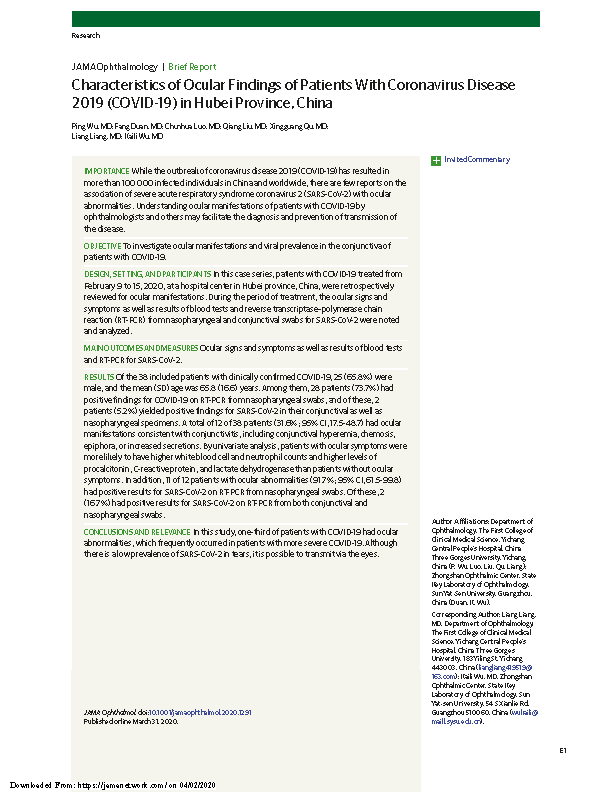Apr 02 Characteristics of Ocular Findings of Patients With Coronavirus Disease 2019 (COVID-19) in Hubei Province, China
Ping Wu, Fang Duan, Chunhua Luo, Qiang Liu, Xingguang Qu, Liang Liang, Kaili Wu
ABSTRACT
Importance: While the coronavirus disease 2019 (COVID-19) outbreak resulted in more than 100.000 people being infected in China and around the world, there are few reports on the association of severe acute respiratory syndrome coronavirus 2 (SARS-CoV- 2) with ocular abnormalities.
Understanding the ocular manifestations of patients with COVID-19 by ophthalmologists and other specialists can facilitate diagnosis and prevention of disease transmission.
Objective: To investigate the ocular manifestations and viral prevalence in the conjunctiva of patients with COVID-19.
Design, setting and participants: In this case series, patients with COVID-19 treated from February 9 to 15, 2020, at a hospital facility in Hubei Province, China, were retrospectively reviewed for ocular manifestations.
During the treatment period, ocular signs and symptoms, as well as the results of blood tests and RT-PCT of nasopharyngeal and conjunctival swabs for SARS-CoV-2 were analyzed.
Main results and measures: Ocular signs and symptoms, as well as the results of blood tests and RT-PCR for SARS-CoV-2.
Results: Of the 38 included patients with clinically confirmed COVID-19, 25 (65.8%) were male and the mean (SD) age was 65,8 (16,6) years. Among them, 28 patients (73,7%) had positive results for COVID-19 in RT-PCR of nasopharyngeal swabs, and of these, 2 patients (5,2%) had positive results for SARS-CoV-2 in their conjunctiva. , as well as in nasopharyngeal samples:
- A total of 12 of 38 patients (31.6%; 95% CI, 17.5-48.7) had ocular manifestations consistent with conjunctivitis, including conjunctival hyperemia, chemosis, tearing, or increased discharge.
- By univariate analysis, patients with ocular symptoms were more likely to have higher white blood cell and neutrophil counts and higher levels of procalcitonin, C-reactive protein, and lactate dehydrogenase than patients without ocular symptoms.
- In addition, 11 of the 12 patients with ocular abnormalities (91.7%; 95% CI, 61.5-99.8) had positive results for SARS-CoV-2 on RT-PCR of nasopharyngeal swabs. Of these, 2 (16,7%) had positive results for SARS-CoV-2 on RT-PCR on both conjunctiva and nasopharyngeal swabs.
Conclusions and relevance: In this study, one third of patients with COVID-19 had ocular abnormalities, which frequently occurred in patients with more severe COVID-19. Despite the low prevalence of SARS-CoV-2 in tears, transmission through the eyes is possible.



